A test plan is a detailed document which describes software testing areas and activities. It outlines the test strategy, objectives, test schedule, required resources (human resources, software, and hardware), test estimation and test deliverables.
The test plan is a base of every software's testing. It is the most crucial activity which ensures availability of all the lists of planned activities in an appropriate sequence.
The test plan is a template for conducting software testing activities as a defined process that is fully monitored and controlled by the testing manager. The test plan is prepared by the Test Lead (60%), Test Manager(20%), and by the test engineer(20%).
Types of Test Plan
There are three types of the test plan
- Master Test Plan
- Phase Test Plan
- Testing Type Specific Test Plans
Master Test Plan
Master Test Plan is a type of test plan that has multiple levels of testing. It includes a complete test strategy.
Phase Test Plan
A phase test plan is a type of test plan that addresses any one phase of the testing strategy. For example, a list of tools, a list of test cases, etc.
Specific Test Plans
Specific test plan designed for major types of testing like security testing, load testing, performance testing, etc. In other words, a specific test plan designed for non-functional testing.
How to write a Test Plan
Making a test plan is the most crucial task of the test management process. According to IEEE 829, follow the following seven steps to prepare a test plan.
- First, analyze product structure and architecture.
- Now design the test strategy.
- Define all the test objectives.
- Define the testing area.
- Define all the useable resources.
- Schedule all activities in an appropriate manner.
- Determine all the Test Deliverables.
Test plan components or attributes
The test plan consists of various parts, which help us to derive the entire testing activity.
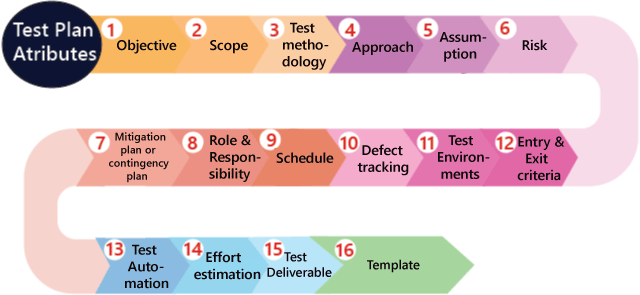
Objectives: It consists of information about modules, features, test data etc., which indicate the aim of the application means the application behavior, goal, etc.
Scope: It contains information that needs to be tested with respective of an application. The Scope can be further divided into two parts:
- In scope
- Out scope
In scope: These are the modules that need to be tested rigorously (in-detail).
Out scope: These are the modules, which need not be tested rigorously.
For example, Suppose we have a Gmail application to test, where features to be tested such as Compose mail, Sent Items, Inbox, Drafts and the features which not be tested such as Help, and so on which means that in the planning stage, we will decide that which functionality has to be checked or not based on the time limit given in the product.
Now how we decide which features not to be tested?
We have the following aspects where we can decide which feature not to be tested:
- As we see above that Help features is not going to be tested, as it is written and developed by the technical writer and reviewed by another professional writer.
- Let us assume that we have one application that have P, Q, R, and S features, which need to be developed based on the requirements. But here, the S feature has already been designed and used by some other company. So the development team will purchase S from that company and integrate with additional features such as P, Q, and R.
Now, we will not perform functional testing on the S feature because it has already been used in real-time. But we will do the integration testing, and system testing between P, Q, R, and S features because the new features might not work correctly with S feature as we can see in the below image:
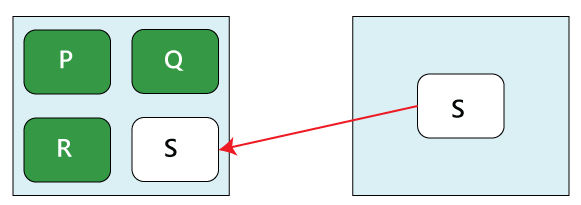
- Suppose in the first release of the product, the elements that have been developed, such as P, Q, R, S, T, U, V, W…..X, Y, Z. Now the client will provide the requirements for the new features which improve the product in the second release and the new features are A1, B2, C3, D4, and E5.
After that, we will write the scope during the test plan as
Scope
Features to be tested
A1, B2, C3, D4, E5 (new features)
P, Q, R, S, T
Features not to be tested
W…..X, Y, Z
Therefore, we will check the new features first and then continue with the old features because that might be affected after adding the new features, which means it will also affect the impact areas, so we will do one round of regressing testing for P, Q, R…, T features.
Test methodology:
It contains information about performing a different kind of testing like Functional testing, Integration testing, and System testing, etc. on the application. In this, we will decide what type of testing; we will perform on the various features based on the application requirement. And here, we should also define that what kind of testing we will use in the testing methodologies so that everyone, like the management, the development team, and the testing team can understand easily because the testing terms are not standard.
For example, for standalone application such as Adobe Photoshop, we will perform the following types of testing:
Smoke testing→ Functional testing → Integration testing →System testing →Adhoc testing → Compatibility testing → Regression testing→ Globalization testing → Accessibility testing → Usability testing → Reliability testing → Recovery testing → Installation or Uninstallation testing
And suppose we have to test the https://www.jeevansathi.com/ application, so we will perform following types of testing:
|
Smoke
testing |
Functional
testing |
Integration
testing |
|
System
testing |
Adhoc
testing |
Compatibility
testing |
|
Regression
testing |
Globalization
testing |
Accessibility
testing |
|
Usability
testing |
Performance
testing |
Approach
This attribute is used to describe the flow of the application
while performing testing and for the future reference.
We can understand the flow of the application with the help of
below aspects:
- By writing the high-level scenarios
- By writing the flow graph
By writing the
high-level scenarios
For example, suppose we are testing
the Gmail application:
- Login to Gmail- sends an email and
check whether it is in the Sent Items page
- Login to …….
- ……
- …....
We are writing this to describe the approaches which have to be
taken for testing the product and only for the critical features where we will
write the high-level scenarios. Here, we will not be focusing on covering all
the scenarios because it can be decided by the particular test engineer that
which features have to be tested or not.
By writing the flow graph
The flow graph is written because writing the high-level scenarios are bit time taking process, as we can see in the below image:
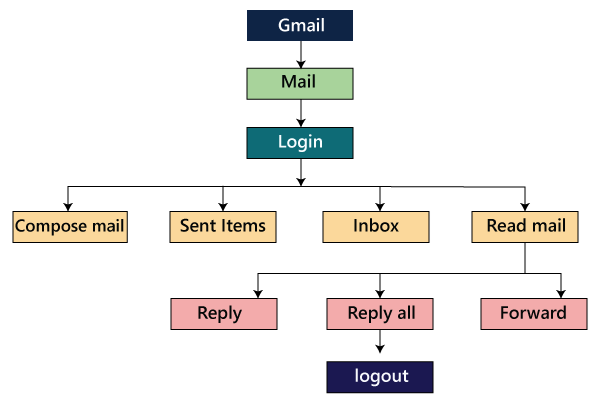
We are creating flow graphs to make the following benefits such as:
- Coverage is easy
- Merging is easy
The approach can be classified into two parts which are as following:
- Top to bottom approach
- Bottom to top approach
Assumption
It contains information about a problem or issue which maybe occurred during the testing process and when we are writing the test plans, the assured assumptions would be made like resources and technologies, etc.
Risk
These are the challenges which we need to face to test the application in the current release and if the assumptions will fail then the risks are involved.
For example, the effect for an application, release date becomes postponed.
Mitigation Plan or Contingency Plan
It is a back-up plan which is prepared to overcome the risks or issues.
Let us see one example for assumption, risk, and the contingency plan together because they are co-related to each other.
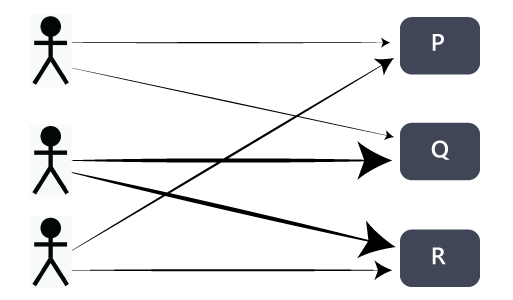
In any product, the assumption we will make is that the all 3 test engineers will be there until the completion of the product and each of them is assigned different modules such as P, Q, and R. In this particular scenario, the risk could be that if the test engineer left the project in the middle of it.
Therefore, the contingency plan will be assigned a primary and subordinate owner to each feature. So if the one test engineer will leave, the subordinate owner takes over that specific feature and also helps the new test engineer, so he/she can understand their assigned modules.
The assumptions, risk, and mitigation or contingency plan are always precise on the product itself. The various types of risks are as follows:
- Customer perspective
- Resource approach
- Technical opinion
Role & Responsibility
It defines the complete task which needs to be performed by the entire testing team. When a large project comes, then the Test Manager is a person who writes the test plan. If there are 3-4 small projects, then the test manager will assign each project to each Test Lead. And then, the test lead writes the test plan for the project, which he/she is assigned.
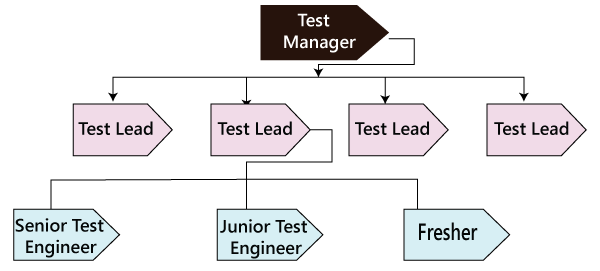
Let see one example where we will understand the roles and responsibility of the Test manager, test lead, and the test engineers.
Role: Test Manager
Name: Ryan
Responsibility:
- Prepare( write and review) the test plan
- Conduct the meeting with the development team
- Conduct the meeting with the testing team
- Conduct the meeting with the customer
- Conduct one monthly stand up meeting
- Sign off release note
- Handling Escalations and issues
Role: Test Lead
Name: Harvey
Responsibility:
- Prepare( write and review) the test plan
- Conduct daily stand up meeting
- Review and approve the test case
- Prepare the RTM and Reports
- Assign modules
- Handling schedule
Role: Test Engineer 1, Test Engineer 2 and Test Engineer 3
Name: Louis, Jessica, Donna
Assign modules: M1, M2, and M3
Responsibility:
- Write, Review, and Execute the test documents which consists of test case and test scenarios
- Read, review, understand and analysis the requirement
- Write the flow of the application
- Execute the test case
- RTM for respective modules
- Defect tracking
- Prepare the test execution report and communicate it to the Test Lead.
Schedule
It is used to explain the timing to work, which needs to be done or this attribute covers when exactly each testing activity should start and end? And the exact data is also mentioned for every testing activity for the particular date.
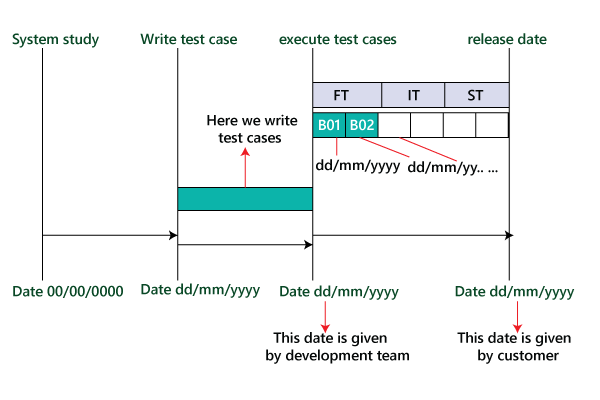
Therefore as we can see in the below image that for the particular activity, there will be a starting date and ending date; for each testing to a specific build, there will be the specified date.
For example
- Writing test cases
- Execution process
Defect tracking
It is generally done with the help of tools because we cannot track the status of each bug manually. And we also comment about how we communicate the bugs which are identified during the testing process and send it back to the development team and how the development team will reply. Here we also mention the priority of the bugs such as high, medium, and low.
Following are various aspects of the defect tracking:
- Techniques to track the bug
…..
……
……
…… - Bug tracking tools
We can comment on the name of the tool, which we will use for tracking the bugs. Some of the most commonly used bug tracking tools are Jira, Bugzilla, Mantis, and Trac, etc.< - Severity
The severity could be as following:
Blocker or showstopper
…..
….. (Explain it with an example in the test plan)
For example, there will be a defect in the module; we cannot go further to test other modules because if the bug is blocked, we can proceed to check other modules.
Critical
……
….. (Explain it with an example in the test plan)
In this situation, the defects will affect the business.
Major
….
…. (Explain it with an example in the test plan)
Minor
…..
….. (Explain it with an example in the test plan)
These defects are those, which affect the look and feel of the application. - Priority
High-P1
…..
Medium-P2
…..
Low-P3
…..
…..
P4
Therefore, based on the priority of bugs liike high, medium, and low, we will categorize it as P1, P2, P3, and P4.
Test Environments
These are the environments where we will test the application, and here we have two types of environments, which are of software and hardware configuration.
The software configuration means the details about different Operating Systems such as Windows, Linux, UNIX, and Mac and various Browsers like Google Chrome, Firefox, Opera, Internet Explorer, and so on.
And the hardware configuration means the information about different sizes of RAM, ROM, and the Processors.
For example
- The Software includes the following:
Server
|
Operating
system |
Linux |
|
Webserver |
Apache
Tomcat |
|
Application
server |
Websphere |
|
Database
server |
Oracle or
MS-SQL Server |
Note: The above servers are the serves that
are used by the testing team to test the application.
Client
|
Operating
System |
Window
XP, Vista 7 |
|
Browsers |
Mozilla
Firefox, Google Chrome, Internet Explorer, Internet Explorer 7, and Internet
Explorer 8 |
Note: The above details provide the various
operating systems and browsers in which the testing team will test the
application.
- The Hardware includes
the following:
Server: Sun StarCat 1500
This particular server can be used by the testing team to test
their application.
Client:
It has the following configuration, which is as follows:
|
Processor |
Intal2GHz |
|
RAM |
2GB |
|
…. |
…. |
Note: It will provide the configuration of
the systems of the test engineers that is the testing team.
- Process to install the software
……
…..
…..
The development team will provide the configuration of how to
install the software. If the development team will not yet provide the process,
then we will write it as Task-Based Development (TBD) in the test plan.
Entry
and Exit criteria
It is a necessary condition, which needs to be satisfied before
starting and stopping the testing process.
Entry Criteria
The entry criteria contain the following conditions:
- White box testing should be finished.
- Understand and analyze the
requirement and prepare the test documents or when the test documents are
ready.
- Test data should be ready.
- Build or the application must be
prepared
- Modules or features need to be
assigned to the different test engineers.
- The necessary resource must be ready.
Exit Criteria
The exit criteria contain the following conditions:
- When all the test cases are executed.
- Most of the test cases must be passed.
- Depends on severity of the bugs which
means that there must not be any blocker or major bug, whereas some minor
bugs exist.
Before we start performing functional testing, all the
above Entry
Criteria should be followed. After we performed functional
testing and before we will do integration testing, then the Exit criteria of the
functional testing should be followed because the % of exit criteria are
decided by the meeting with both development and test manager because their
collaboration can achieve the percentage. But if the exit
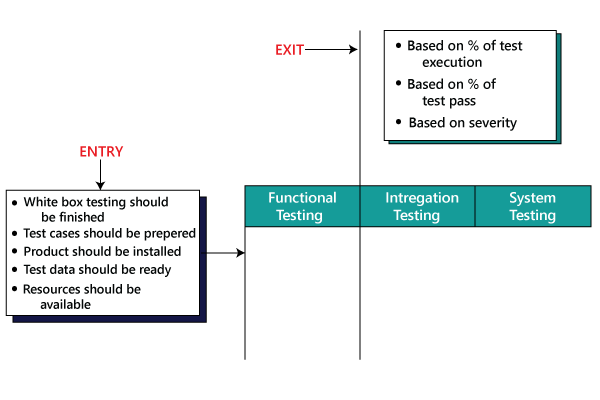
Here based on the severity of the bug's means that the testing team would have decided that to proceed further for the next phases.
Test Automation
In this, we will decide the following:
- Which feature has to be automated and not to be automated?
- Which test automation tool we are going to use on which automation framework?
We automate the test case only after the first release.
Here the question arises that on what basis we will decide which features have to be tested?
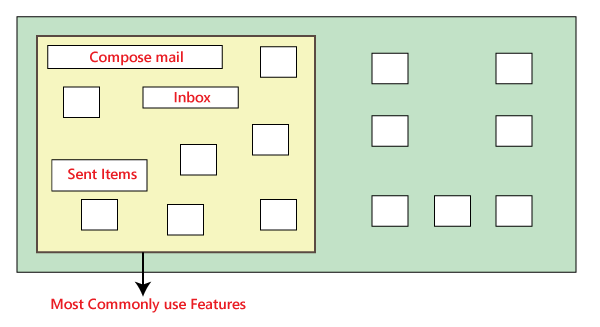
In the above image, as we can see that the most commonly used features need to test again and again. Suppose we have to check the Gmail application where the essential features are Compose mail, Sent Items, and Inbox. So we will test these features because while performing manual testing, it takes more time, and it also becomes a monotonous job.
Now, how we decide which features are not going to be tested?
Suppose the Help feature of the Gmail application is not tested again and again because these features are not regularly used, so we do not need to check it frequently.
But if some features are unstable and have lots of bugs, which means that we will not test those features because it has to be tested again and again while doing manual testing.
If there is a feature that has to be tested frequently, but we are expecting the requirement change for that feature, so we do not check it because changing the manual test cases is more comfortable as compared to change in the automation test script.
Effort estimation
In this, we will plan the effort need to be applied by every team member.
Test Deliverable
These are the documents which are the output from the testing team, which we handed over to the customer along with the product. It includes the following:
- Test plan
- Test Cases
- Test Scripts
- RTM(Requirement Traceability Matrix)
- Defect Report
- Test Execution Report
- Graphs and metrics
- Release Notes
Graphs and Metrics
Graph
In this, we will discuss about the types of graphs we will send, and we will also provide a sample of each graph.
As we can see, we have five different graphs that show the various aspects of the testing process.
Graph1: In this, we will show how many defects have been identified and how many defects have been fixed in every module.
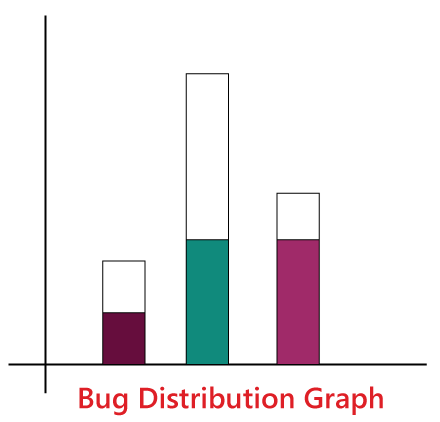
Graph 2: Figure one shows how many critical, major, and minor defects have been identified for every module and how many have been fixed for their respective modules.
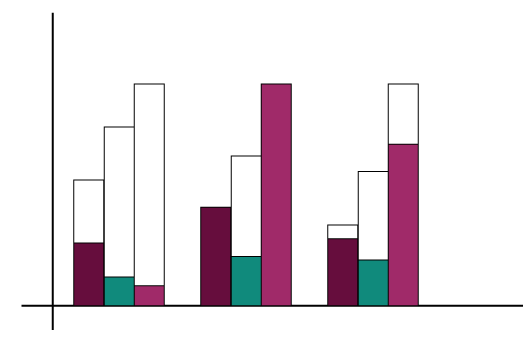
Graph3: In this particular graph, we represent the build wise graph, which means that in every builds how many defects have been identified and fixed for every module. Based on the module, we have determined the bugs. We will add R to show the number of defects in P and Q, and we also add S to show the defects in P, Q, and R.
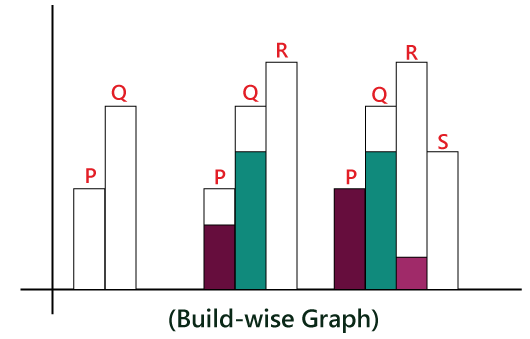
Graph4: The test lead will design the Bug Trend analysis graph which is created every month and send it to the Management as well. And it is just like prediction which is done at the end of the product. And here, we can also rate the bug fixes as we can observe that arc has an upward tendency in the below image.
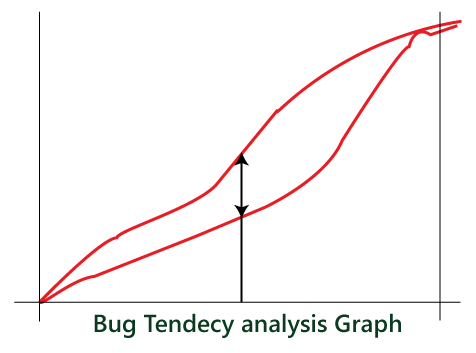
Graph5: The Test Manager has designed this type of graph. This graph is intended to understand the gap in the assessment of bugs and the actual bugs which have been occurred, and this graph also helps to improve the evaluation of bugs in the future.

Metrics
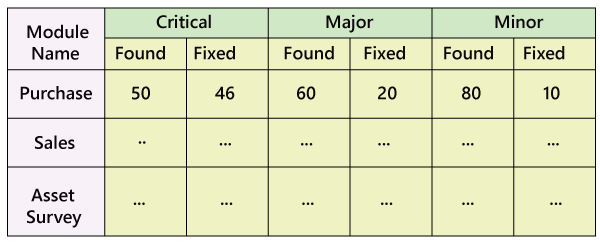
As above, we create the bug distribution graph, which is in the figure 1, and with the help of above mention data, we will design the metrics as well.
For example
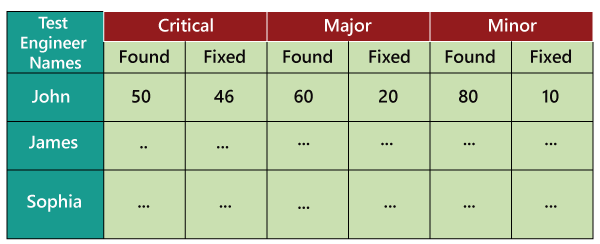
In the above figure, we retain the records of all the test engineers in a particular project and how many defects have been identified and fixed. We can also use this data for future analysis. When a new requirement comes, we can decide whom to provide the challenging feature for testing based on the number of defects they have found earlier according to the above metrics. And we will be in a better situation to know who can handle the problematic features very well and find maximum numbers of defects.
Release Note: It is a document that is prepared during the release of the product and signed by the Test Manager.
In the below image, we can see that the final product is developed and deployed to the customer, and the latest release name is Beta.
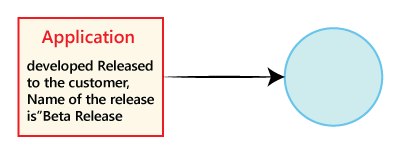
The Release note consists of the following:
- User manual.
- List of pending and open defects.
- List of added, modified, and deleted features.
- List of the platform (Operating System, Hardware, Browsers) on which the product is tested.
- Platform in which the product is not tested.
- List of bugs fixed in the current release, and the list of fixed bugs in the previous release.
- Installation process
- Versions of the software
For Example
Suppose that Beta is the second release of the application after the first release Alpha is released. Some of the defect identified in the first released and that has been fixed in the later released. And here, we will also point out the list of newly added, modified, and deleted features from alpha release to the beta release.

Template
This part contains all the templates for the documents that will be used in the product, and all the test engineers will use only these templates in the project to maintain the consistency of the product. Here, we have different types of the template which are used during the entire testing process such as:
- Test case template
- Test case review template
- RTM Template
- Bug Report Template
- Test execution Report
Let us see one sample of test plan document
Page-1
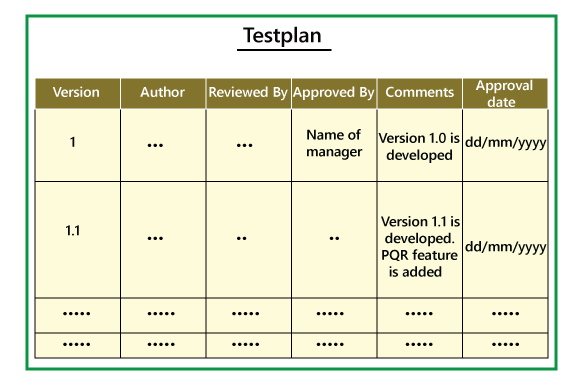
Page3-page18
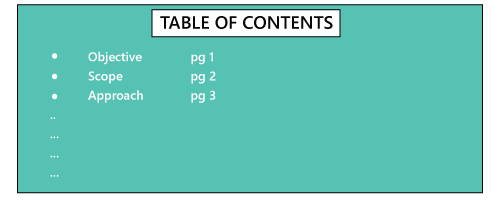
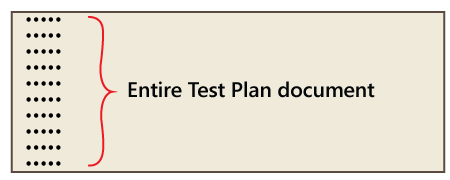
Page-20
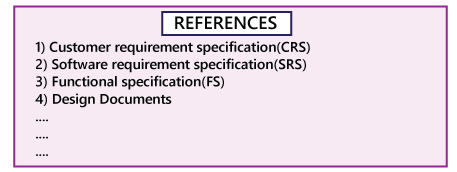
In-Page 1, we primarily fill only the Versions, Author, Comments, and Reviewed By fields, and after the manager approves it, we will mention the details in the Approved By and Approval Date fields.
Mostly the test plan is approved by the Test Manager, and the test engineers only reviews it. And when the new features come, we will modify the test plan and do the necessary modification in Version field, and then it will be sent again for further review, update, and approval of the manager. The test plan must be updated whenever any changes have occurred. On page 20, the References specify the details about all the documents which we are going to use to write the test plan document.
Note:
Who writes the test plan?
- Test Lead→60%
- Test Manager→20%
- Test Engineer→20%
Therefore, as we can see from above that in 60% of the product, the test plan is written by the Test Lead.
Who reviews the Test Plan?
- Test Lead
- Test Manager
- Test engineer
- Customer
- Development team
The Test Engineer review the Test plan for their module perspective and the test manager review the Test plan based on the customer opinion.
Who approve the test Plan?
- Customer
- Test Manager
Who writes the test case?
- Test Lead
- Test Engineer
Who review the test case?
- Test Engineer
- Test Lead
- Customer
- Development Team
Who approves the Test cases?
- Test Manager
- Test Lead
- Customer
Test Plan Guidelines
- Collapse your test plan.
- Avoid overlapping and redundancy.
- If you think that you do not need a section that is already mentioned above, then delete that section and proceed ahead.
- Be specific. For example, when you specify a software system as the part of the test environment, then mention the software version instead of only name.
- Avoid lengthy paragraphs.
- Use lists and tables wherever possible.
- Update plan when needed.
- Do not use an outdated and unused document.
Importance of Test Plan
- The test plan gives direction to our thinking. This is like a rule book, which must be followed.
- The test plan helps in determining the necessary efforts to validate the quality of the software application under the test.
- The test plan helps those people to understand the test details that are related to the outside like developers, business managers, customers, etc.
- Important aspects like test schedule, test strategy, test scope etc are documented in the test plan so that the management team can review them and reuse them for other similar projects.



0 Comments